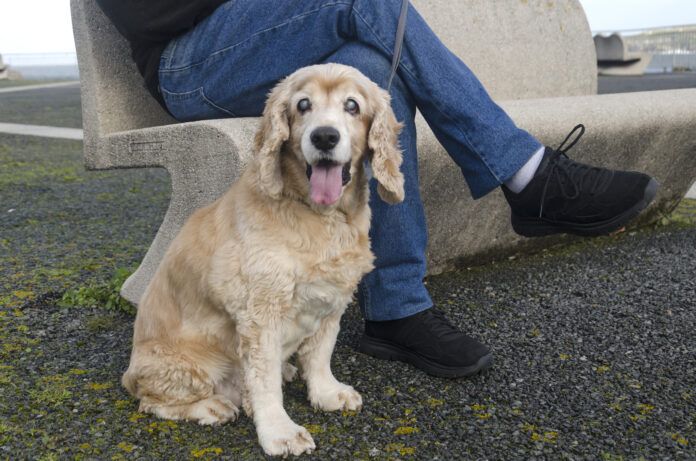When we were in Europe last fall, we noticed that Sparkles was walking into an awful lot of glass doors and sometimes walls. She was also less fearless about going down stairs, something that never bothered her previously. We’ve noticed that she seems to startle more frequently, at what appears to be nothing. And like our late Pomeranian-Chihuahua mix, Gemma, she sometimes has problems following our hand movements when we’re setting down her food bowl or handing out treats. Sparkles will be 13 years old in April, so it’s not really a surprise that her eyesight is starting to go.
If dogs live long enough—and sometimes even when they’re young—at some point they’re probably going to experience vision loss. The good news is that a blind dog can usually adjust well to their new condition, ramping up use of smell and hearing and sometimes even whiskers to navigate their environment. There are ways you can help them, too.
Seeing What’s Going On
Dogs are so adept at using their other senses to make their way through their surroundings that it can take some time to notice that their eyesight is failing. Clues on how to tell if your dog is having vision problems or may have eye disease include all of the behaviors we noticed with Sparkles and Gemma, as well as physical changes:
- Redness
- Discharge
- Cloudiness or opacity in the lens of the eye
- Change in eye color
- Squinting and tearing
- Sensitivity to light
- Pawing at the eye
- A swollen, crusty, or itchy eyelid
- An unusually hard or soft eye
- A bulging or sunken eye
Not all of these signs are caused by straightforward vision loss due to aging. Glaucoma—painful increased pressure within the eye—can cause blindness within 48 hours if it isn’t recognized and treated right away. Injuries, infection, or eye diseases like glaucoma can result in enucleation—removal of one or both eyes.
If you think your dog is going blind, take her to the veterinarian for an exam to confirm the diagnosis and make sure it’s not caused by a treatable condition such as high blood pressure or diabetes. Medication or surgery, such as cataract removal, can often help, especially if the problem is diagnosed early.
Helping Dogs Adjust to Blindness
Often, dogs adjust to vision loss before we notice it has happened, especially if blindness occurs gradually. When they lose vision rapidly, however, it may take them a few weeks to become accustomed to their new situation. Fortunately, their keen senses of smell and hearing aid them as vision fades. Whiskers are packed with sensitive touch receptors that help dogs navigate their environment, aiding in measuring distance and detecting faint vibrations caused by air movement. Environmental management, training, and even an assist from other pets can help as well.
Routine rules. Dogs are creatures of habit. Keeping things the same will allow them to make their way around confidently, whether it’s in the home or outdoors. Some tips for helping blind dogs navigate include:
- Avoid moving furniture if possible. When you must, try marking it at nose level with a scent aid such as perfume or an essential oil to grab your dog’s olfactory attention.
- Pick up items off the floor so they’re not in the way.
- Cushioning on sharp edges can help to prevent startling bumps or bruises until your dog gets used to the new setup.
- Use a baby gate to keep your dog away from the stairs until you’re sure they can navigate them safely.
- Keep food and water bowls in the same place. They can serve as an anchor point. If your dog seems lost in the house, take her to the feeding area. That can help to reorient her.
- At first, stick to walking routes your dog knows well. The familiar scents along the way will help guide her, and she’ll likely already know about obstacles such as curbs or steps.
Use your voice. In the house or on a walk, talk to your dog so they can tell where you are.
Pay attention to your dog’s voice. Is she barking more often? It may be a way of saying “Hey, where are you?” This is another instance where talking to her can help her to feel more secure, especially if vision loss occurred suddenly.
Training helps dogs to gain and maintain confidence. Loss of sight doesn’t have to mean loss of training. Using a clicker and treats or verbal praise are great ways to guide and reward dogs who can’t see. For instance, teach verbal cues such as “step up” or “step down” for use at curbs or stairs. The mental stimulation of training is also important for maintaining cognitive health, especially as dogs age.
Guide pets? There are lots of heartwarming anecdotes, news stories, Insta posts, and YouTube videos of animals with vision loss who have assistants in the form of other dogs or cats in the home. Sighted pets can help to redirect them if they lose their way or to find their food bowl, toys or bed. Sometimes they bark or meow to get the blind dog back on track.
Eye Loss in Dogs
Is it cruel to keep a blind dog? While for humans, loss of eyesight is considered a tragedy, dogs are not so reliant on vision since they don’t drive or read. A dog going blind can adapt extremely well to the change, especially if blindness occurs gradually. Even if a dog needs to have one or both eyes removed, they generally adjust rapidly. They don’t have preconceived ideas about what it means to lose an eye or worries about how they’ll manage. They just get on with it.






